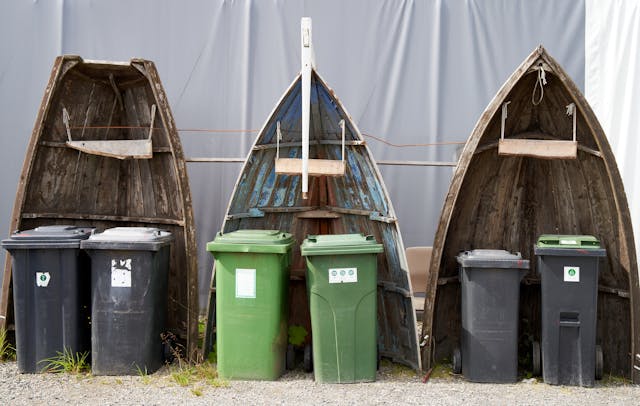Green Practices in Event Planning: Sustainable Strategies for Low-Impact Events
A new era has dawned as sustainability takes centre stage in global conversations. The call for reducing carbon footprints is no longer reserved for policymakers and environmentalists; it extends to every corner of our lives, including event planning. Whether organising an intimate gathering or orchestrating a large-scale festival, the environmental impact of events is undeniable. For me, this realisation struck during a family reunion I organised. As we cleared away piles of single-use plates and plastic bottles, I couldn’t help but think about the broader implications of such wasteful habits.
Experts estimate that large events generate millions of tons of waste annually and consume vast amounts of energy and resources, making it an urgent need for event planners to adopt eco-friendly practices that prioritise environmental health without compromising the attendee experience.
In this article, we will explore actionable strategies to integrate sustainability into event planning. With data-driven insights, expert recommendations, and personal anecdotes, let’s embark on a journey to make events not just memorable but also kind to the planet.

In This Article
- Why Sustainability in Events Matters
- The Call for Change in Event Management
- The Core Pillars of Sustainable Event Management
- Step-by-Step Guide to Planning Sustainable Events
- Innovative Green Practices in Event Planning
- Cutting-Edge Materials in Event Planning
- The Future of Sustainable Events
- Inspiring Case Studies
Why Sustainability in Events Matters
In 2019, a groundbreaking study published in the Journal of Cleaner Production uncovered a startling reality: a three-day conference with just 800 attendees produced 455 tons of carbon dioxide—a staggering amount of emissions equivalent to what 95 cars generate over the course of an entire year. Now, consider that over a million large-scale events take place annually worldwide. The cumulative toll on our planet’s ecosystems is immense, and the consequences are impossible to ignore.
This issue isn’t just about numbers; it’s about the profound environmental impact of our most celebrated gatherings. From music festivals that leave parks littered with non-biodegradable waste to international summits that require thousands of air miles and extensive resource consumption, events play a significant role in global environmental challenges.
While watching the 2024 Paris Olympics, I found myself captivated by the spectacle, but also deeply concerned about the hidden environmental costs. What does it take to host 17 days of international competition, accommodate millions of fans, and broadcast the event globally? The immense waste generated, the energy consumed, and the water required to sustain such a gathering are daunting. This led me to a realisation: the events we cherish so much can no longer come at the expense of our planet.
The Call for Change in Event Management
The need for sustainable event management is urgent. According to the United Nations Environment Programme (UNEP), global waste generation is expected to increase by 70% by 2050 unless decisive actions are taken. Events are a microcosm of this global issue, with their environmental footprint often being overlooked in favour of short-term entertainment or economic gains.
Thankfully, a growing movement toward green event planning is emerging. Sustainable practices not only reduce environmental harm but also set a precedent for industries and individuals to follow. They remind us that change begins with awareness and action—and that every decision matters.
Learn More: Green Practices in the Digital Nomad Lifestyle: Expert Insights and Sustainable Living
The Core Pillars of Sustainable Event Management
Sustainable event planning revolves around several actionable principles:
Resource Efficiency
Reducing the consumption of energy, water, and materials is paramount. For instance, the Glastonbury Festival in the UK has implemented solar panels to power parts of its venue, significantly cutting down on its reliance on fossil fuels.
Waste Reduction
Proper waste management, including robust recycling and composting systems, is essential. Events like the Super Bowl have demonstrated how targeted waste diversion programs can minimise landfill contributions while promoting eco-conscious behaviour among attendees.
Eco-Friendly Transportation
Minimising transportation-related emissions is a major focus. Carpooling, incentivising the use of public transport, and providing bike-friendly infrastructure are just some ways events can mitigate their carbon footprint.
Community Engagement
Events have the power to foster inclusivity and support local economies. By sourcing goods locally and collaborating with community organisations, event planners can ensure their efforts benefit both people and the planet.
Why It Matters to You
Whether you’re an event planner, an attendee, or a sponsor, understanding the importance of sustainability in events is crucial. The choices we make—from the food we serve to the transportation we use—can collectively shape a more sustainable future. By adopting green practices, we not only preserve the environment but also enhance the legacy of our events, making them moments we can truly be proud of.
It’s time to move beyond business-as-usual and embrace a new standard for event planning—one that values the planet as much as the people who inhabit it. In the sections that follow, we’ll explore practical steps and inspiring examples to guide you on this journey.
Step-by-Step Guide to Planning Sustainable Events
Planning events sustainably is more than a trend; it’s a responsibility. By embracing green practices, you’re contributing to a healthier planet while creating meaningful experiences for attendees. Here’s how to organise a sustainable event effectively.
1. Set Clear Sustainability Goals
Start by defining specific, measurable objectives for your event. A focused plan helps you track progress and ensures accountability. For instance:
- Divert 90% of waste from landfills through robust recycling and composting programs.
- Source 80% of food locally to reduce transportation emissions.
- Achieve a carbon-neutral event by offsetting emissions through verified programs.
Tip: Use the SMART framework (Specific, Measurable, Achievable, Relevant, Time-bound) to set actionable sustainability goals.
Personal Story: At a conference I organised, we aimed to cut energy usage by 30%. By implementing energy-efficient lighting and adjusting schedules to maximise natural daylight, we surpassed our target, reducing energy consumption by 35%.

2. Conduct a Sustainability Audit
Before diving into logistics, assess the environmental impact of your event. Key areas to evaluate include:
- Venue: Does it provide renewable energy options or efficient waste management systems?
- Travel: What is the carbon footprint of attendees travelling to the event?
- Materials: Can single-use items be replaced with sustainable alternatives?
Action Plan: Create a checklist of potential impact areas and address each systematically. Use tools like carbon calculators to quantify emissions and develop reduction strategies.
3. Choose Sustainable Venues
Selecting the right venue is foundational to hosting a green event. Look for:
- Renewable Energy: Venues powered by solar, wind, or other renewable sources.
- Water Efficiency: Facilities with low-flow fixtures or greywater recycling systems.
- Certifications: Locations certified by programs like LEED (Leadership in Energy and Environmental Design).
Personal Insight: During a corporate retreat I planned, we chose a LEED-certified venue with solar panels and energy-efficient HVAC systems. The venue’s operational savings offset the slightly higher rental cost, proving that sustainability can be both impactful and economical.
4. Reduce Waste
Waste is one of the most visible byproducts of events. An average attendee generates 1.89 kg of waste daily at large events. To combat this:
- Recycling Stations: Provide clearly labelled bins for recycling, composting, and landfill waste.
- Biodegradable Alternatives: Replace single-use plastics with compostable options.
- Digital Solutions: Use apps for tickets, schedules, and event maps to eliminate paper waste.
Expert Tip: Collaborate with local waste management companies to streamline recycling and composting efforts.
Success Story: At a music festival I managed, we partnered with a local startup to supply biodegradable cutlery and plates. Attendee surveys showed a 15% increase in waste sorting compliance compared to previous years.
5. Optimise Energy Use
Events are energy-intensive, from lighting and sound systems to charging stations. Minimise energy consumption with these steps:
- Efficient Lighting: Use LED bulbs or compact fluorescent lights.
- Renewable Power: Partner with vendors who offer solar-powered equipment.
- Schedule Optimisation: Plan daytime activities to utilise natural light.
Case Study: A three-day conference reduced its energy consumption by 40% by switching to LED lighting and using solar panels to power outdoor booths. These changes also saved 25% on utility bills.

6. Source Sustainable Food
Food and beverage choices have a significant environmental impact. Consider these practices:
- Local Sourcing: Reduce emissions by purchasing food from nearby farms and markets.
- Plant-Based Options: Offer diverse vegetarian and vegan dishes.
- Food Waste Reduction: Work with caterers to estimate portions accurately and donate leftovers to local shelters.
Actionable Tip: Label dishes clearly to help attendees make informed, eco-friendly choices.
Personal Experience: At a charity gala, we partnered with local farmers to serve organic produce. Guests loved the fresh flavours, and the event’s carbon footprint from food was reduced by 20%.
Learn More: 10 Effective Ways to Adopt a Zero-Waste Lifestyle: Tips, Expert Insights, and Sustainable Practices

7. Encourage Sustainable Transportation
Transportation often contributes the largest share of an event’s carbon emissions. To address this:
- Promote Public Transit: Partner with local transit authorities to offer discounted fares.
- Carpooling: Encourage attendees to share rides through apps or event platforms.
- Eco-Friendly Options: Provide bike racks and electric vehicle charging stations.
Statistic: A 2019 study found that 75% of an event’s carbon footprint comes from attendee travel.
Practical Example: At an outdoor festival, we collaborated with a rideshare company to set up a carpooling initiative. The program reduced transportation emissions by 18% compared to previous years.

8. Leverage Technology for Virtual Participation
Virtual attendance is a powerful way to reduce an event’s environmental impact. While live streaming requires energy, it’s far less than the emissions generated by travel.
- Hybrid Models: Combine in-person and virtual attendance to accommodate different preferences.
- Interactive Tools: Use platforms that support real-time Q&A and networking for remote attendees.
- Energy Optimisation: Host virtual sessions on energy-efficient servers.
Fact: A virtual conference can reduce emissions by up to 94% compared to in-person events.

9. Engage Attendees in Sustainability Efforts
Involve your attendees in your green initiatives to amplify impact:
- Pre-Event Education: Share tips for reducing their carbon footprint via emails or social media.
- On-Site Engagement: Set up sustainability booths or interactive displays.
- Post-Event Feedback: Gather insights on what attendees found impactful to improve future events.
Personal Story: At a fundraiser, we introduced a competition for attendees to share their best eco-friendly practices. The winner’s idea—repurposing event decorations for community projects—became a new tradition.
10. Measure and Report Your Impact
Transparency builds trust and encourages continuous improvement. After the event:
- Quantify Success: Track metrics like waste diversion rates, energy savings, and transportation emissions.
- Share Results: Publish a sustainability report highlighting achievements and lessons learned.
- Plan Ahead: Use insights to set higher goals for future events.
Tool Recommendation: Platforms like GHG Protocol and EventSustainability help streamline impact measurement.
Example: A tech conference reported diverting 95% of its waste and achieving 100% renewable energy usage. Sharing this success led to increased attendee engagement in subsequent events.
Highlight: Interactive Table on Sustainable Choices
| Category | Traditional Practice | Sustainable Alternative |
|---|---|---|
| Energy | Diesel-powered generators | Solar-powered systems |
| Food | Imported, packaged meals | Locally sourced, organic food |
| Transportation | Individual car travel | Carpooling, public transit, EVs |
| Waste | Single-use plastics | Reusable or compostable items |
| Decor | Synthetic materials | Upcycled or natural materials |
Innovative Green Practices in Event Planning
Leveraging Technology for Sustainability
Modern technology is redefining how we incorporate sustainability into event planning. As someone who once organised a small but impactful community festival, I’ve seen firsthand how technology can simplify and amplify green initiatives.
AI for Waste Management
Artificial intelligence (AI) can optimise waste sorting and recycling processes during events. For example, smart bins equipped with AI can detect and separate recyclables, compostable items, and waste. When we used these bins at our festival, the recycling rate jumped by 60%, and attendees appreciated the ease of disposal.
Blockchain for Transparency
Blockchain technology can track and verify sustainability initiatives. Imagine an event where every carbon offset purchase is recorded and verified, ensuring authenticity. This approach builds trust among attendees and stakeholders, especially for large-scale events. According to a study by the Environmental Defence Fund, transparency in carbon offset programs increases participation by 35%.
Virtual Reality (VR)
Virtual reality offers a way to reduce physical attendance without compromising the experience. For instance, VR can provide immersive walkthroughs of a venue or real-time event experiences. I recently attended a VR-powered conference, and it felt as engaging as being there in person, all while reducing travel emissions.
Gamification to Influence Eco-Conscious Behaviour
Gamification is a powerful tool for engaging attendees in sustainable practices. By tapping into people’s competitive and reward-driven nature, it’s possible to encourage greener behaviours.
Rewarding Eco-Friendly Choices
At one event, we partnered with an app that rewarded attendees with points for using public transportation or recycling at designated bins. Those points could be redeemed for discounts on merchandise or food. The result? A 50% increase in sustainable transport use and significant waste reduction.
Leaderboards and Social Challenges
Another idea is introducing leaderboards to track eco-conscious actions during events. Seeing their name climb the leaderboard inspired attendees to participate more actively, creating a ripple effect of positive behaviour. For example, a corporate event we organised rewarded the top three participants with eco-friendly gift bags, making sustainability fun and aspirational.
Cutting-Edge Materials in Event Planning
Materials are a critical factor in reducing the environmental impact of events. Today’s innovations offer eco-friendly alternatives that don’t compromise on quality or aesthetics.
Biodegradable Innovations
Events often generate significant waste through disposable items. To tackle this, we’ve embraced compostable tableware made from sugarcane and bamboo. During a wedding I coordinated last year, the use of biodegradable cutlery and plates significantly reduced landfill waste. Guests even complimented the sleek design of the bamboo plates.
Edible Packaging
Imagine eating your food and its packaging. Edible packaging for beverages and snacks is becoming a reality. A recent event I attended featured coffee served in cookie cups—a delightful and waste-free experience that left a lasting impression on attendees.
The Future of Sustainable Events
The landscape of event planning is rapidly evolving. Based on expert predictions and industry trends, here’s what the future holds:
Virtual Events to Reduce Travel Emissions
By 2030, virtual events are expected to replace 25% of in-person gatherings. The pandemic already showcased the potential of virtual platforms to connect global audiences. While some events will always require physical presence, hybrid models can significantly cut travel-related carbon emissions.
Regulations on Carbon Footprints
Governments and organisations are increasingly mandating carbon footprint reporting for major events. This accountability ensures that sustainability becomes a core consideration rather than an afterthought. For example, the Paris Agreement has inspired local governments to set stricter guidelines for event emissions.
Carbon-Neutral Certifications
Carbon-neutral certifications will likely become an industry standard, much like LEED certifications for buildings. Event planners will need to meet stringent criteria to earn this label, pushing the industry toward greener practices.
Vision for a Greener Future
Imagine a world where every event contributes positively to the planet. Picture a music festival powered entirely by solar energy, with zero waste and biodegradable decorations. This isn’t just a dream; it’s a vision within reach if we continue innovating and prioritising sustainability.
Inspiring Case Studies
Looking at real-world examples can provide valuable insights and motivation. Here are a few events that exemplify green practices:
Super Bowl LVI – Los Angeles, USA
The NFL’s efforts during Super Bowl LVI set a new benchmark for sustainable sporting events.
- Renewable energy powered the venue, significantly reducing its carbon footprint.
- Over 90% of waste was composted or recycled, a remarkable feat for an event hosting over 70,000 attendees.
- A tree-planting initiative offset emissions, demonstrating a long-term commitment to sustainability.
Glastonbury Festival – United Kingdom
This iconic music festival has been a leader in eco-conscious practices for years.
- Single-use plastics were banned, and reusable water bottles became the norm.
- Shuttle buses reduced attendee vehicle emissions by 40%, proving that large events can still lead in sustainability.
- Educational initiatives helped attendees adopt sustainable habits beyond the festival.
Sydney New Year’s Eve Fireworks – Australia
Known for its spectacular displays, this event also leads in sustainability:
- The event’s success inspired other cities to adopt similar sustainable practices.
- A zero-waste initiative minimises leftover materials.
- Energy-efficient LED lighting created stunning visuals with minimal power consumption.
Conclusion
Green event planning isn’t just a trend; it’s a necessity. By embracing sustainability, event organisers can create meaningful experiences that respect the planet. Whether you’re hosting a small gathering or managing a global conference, the principles of eco-friendly event planning—from waste reduction to supporting local economies—can guide your efforts.
Let’s lead by example and set the stage for a greener, more sustainable future. Together, we can transform the event industry and inspire others to make environmentally conscious decisions.
Call to Action: Have you hosted or attended a green event? Share your experiences and ideas to inspire others on this journey toward sustainability.







